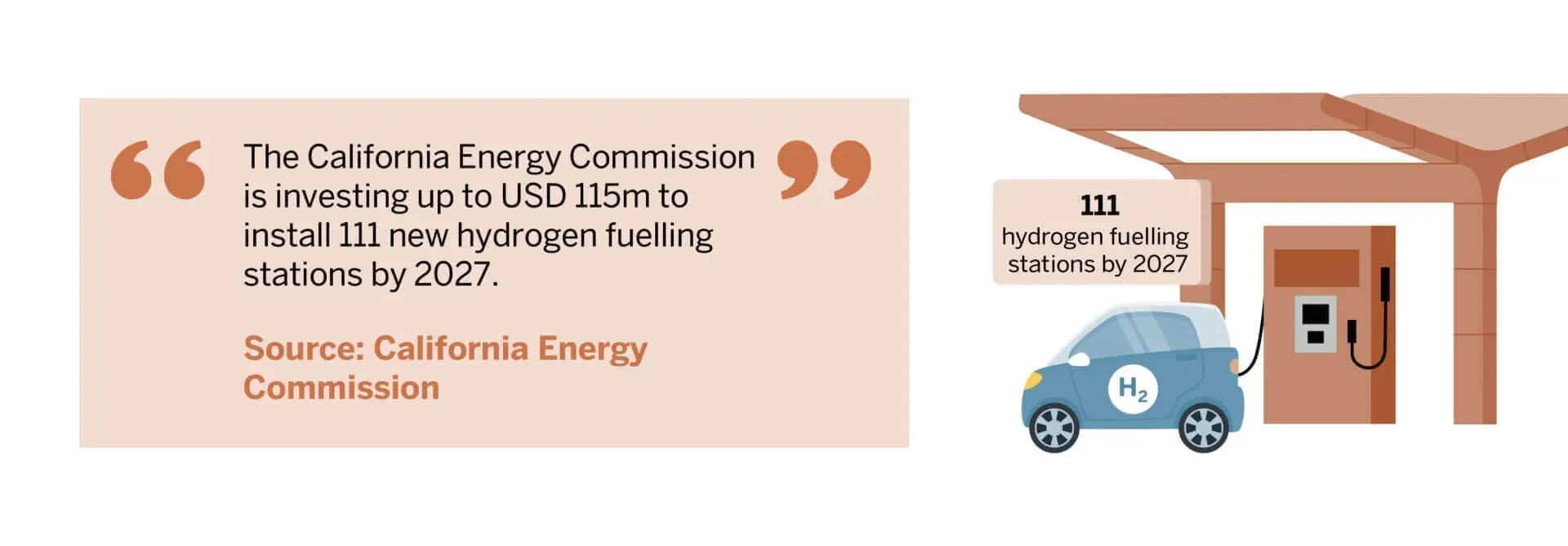First of all, how do hydrogen fuel cells work? A former engineer from Nikola explained that hydrogen atoms, which have one proton and one electron, are passed through a catalyst, resulting in a positively charged hydrogen ion minus its electrons. “The hydrogen ion is passed through an electrolyte while the stripped electrons are passed through a load, like an electric engine, which will ultimately drive you forward.” Oxygen then mixes with the remaining hydrogen atoms to create water – the only output.
One policy decision propelling the shift to hydrogen fuel cell vehicles comes from the Californian authorities. Adopted in 1990 but amended since, the Zero Emission Vehicle Program “has required OEMs to offer zero-emission trucks and vans starting in 2024, hence the race. Therefore, demand for fuel cells is going to increase drastically over the next three years”, the former Nikola executive explained. In addition, as a former senior executive from Hydrogenics Corp told Third Bridge Forum, California is banning all sales of vehicles with internal combustion engines in 2035. The market size for hydrogen powered vehicles is substantial: “The California Fuel Cell Partnership has said there’s a vision to have one million fuel cell vehicles by 2030.”
An advantage highlighted by a former senior executive from Hyzon is its simplicity. “There’s really not a lot to go wrong with the engine. That’s why they can get very long lifespans out of them. Even when they come to the end of the lifespan, the thing that basically in fact goes is the plates.” Replacing the plates means “you get another 10 years out of it”, they continued. In addition, upkeep of vehicles with hydrogen cells costs a “tiny fraction” compared with diesel engines. “The diesel engine takes a lot of maintenance, especially with vehicles for cities where you’re doing a lot of stop-starting, which is heavy work. That’s really tough on a diesel engine.”
Infrastructure, we heard, will be essential for securing uptake of hydrogen-fuelled vehicles. This is a “chicken-and-egg issue”, explained the former Hydrogenics executive. However, “if the infrastructure doesn’t exist, it’s hard to sell a class 8 truck that will go across the country… it’s clear that it’s the infrastructure that has to come first.” The former Nikola engineer expects these to be spaced out at 500-mile intervals.
There has already been some success on this front in California, noted one specialist. The California Energy Commission announced late last year that it would invest up to USD 115m to install 111 new hydrogen fuelling stations by 2027. This commitment is almost twofold of the state’s investment to date. In addition, “California Energy Commission [is] basically promising a steady stream of dollars that go towards partially paying for these hydrogen refuelling stations. They first started at higher percentages. They might pay for 70% and the private company would pay for 30%. Now it’s been 3-4 years since that started, and we’re already seeing that flipping over.”

Another consideration is the cost of electricity. In fact, “the cost of electricity and electrolyser is what makes up most of the cost in producing the hydrogen.” Consequently, it makes more sense for these stations to be situated in rural areas, where such costs are cheaper. An added bonus is that these could even be located near wind or solar farms, “where they can avoid the cost of electricity transmission” as well.
While there are still a lot of obstacles to overcome before mass adoption of hydrogen can occur in this segment, the future looks bright. As awareness of climate change continues to grow in tandem with improved technologies and interest in hydrogen fuel cells, the conditions look optimal for hydrogen vehicles to take off.
The information used in compiling this document has been obtained by Third Bridge from experts participating in Forum Interviews. Third Bridge does not warrant the accuracy of the information and has not independently verified it. It should not be regarded as a trade recommendation or form the basis of any investment decision.
For any enquiries, please contact sales@thirdbridge.com



